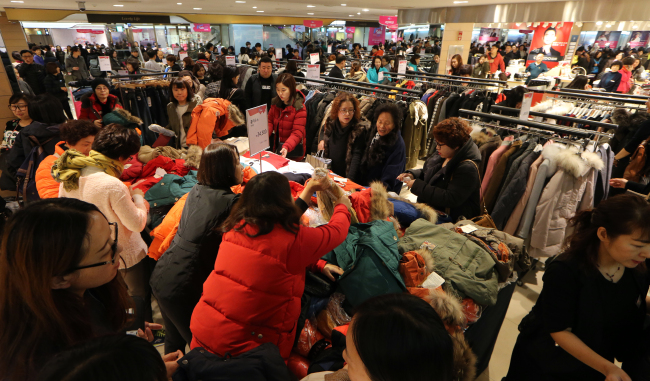As the heyday of the outdoor goods industry in Korea has long passed, related companies are struggling in a saturated market with slowing domestic sales.

The market for outdoor goods boomed between 2005 and 2012 with growth rates often reaching more than 20 percent as people spent more time in the hills and mountains to get away from the stress of work and keep fit.
But the segment’s domestic market value is expected to remain flat in 2015, at the same level as last year’s 7.4 trillion won ($6.3 billion), according to Samsung Fashion Institute.
Experts attribute the stagnation to the plethora of labels that sprang up with the boom.
“The number of outdoor apparel brands has snowballed to more than 170 from some 30 labels in the earlier days as the segment rapidly gained traction,” a Korea Outdoor & Sports Industry Association official said.
North Face, one of the most popular outdoor clothing brands in Korea, saw sales decline to 211.4 billion won in the first nine months this year, down 29 percent over the same period last year, while its operating profit slumped 80 percent to 5.9 billion won.
“There have been signs of market saturation for the last couple of years but we didn’t think it would happen so quickly,” an industry insider said.
In 2014, E-Land Group halted its U.K. outdoor brand Berghaus business after suffering sluggish sales. Sports apparel house FILA said in September it would suspend its business unit for outdoor shoes and apparel in a bid to bolster profitability.
“The closure (of the outdoor products unit) was one of the steps for a brand makeover to surprise customers with completely new products and innovative designs,” a FILA official said.
Shoemaker Kumkang and Shinsegae International also recalled their money-losing outdoor brands.
Sluggish domestic consumption and warmer weather than previous years also dealt a blow to the firms.
Sales of padded jackets that make up over 40 percent of the outdoor clothing makers’ total revenue dropped in the face of waning demand due to the warm winter weather.
“We already ran promotions during the government-led nationwide sales event Korea Black Friday and other events in a bid to persuade shoppers to buy,” said an official at an outdoor good brand who declined to be named.
She said the companies used to clear out inventories during such events, but this year they offered up to 30 percent discounts on newly launched items to reduce their losses.
As a part of efforts to stay afloat, some brands started focusing on golf wear and casual wear.
Local outdoor clothing brand K2, which launched its golf wear label Wide Angle in September 2014, posted 25 billion won in sales from the new label.
“The market is facing a paradigm shift from outdoor to golf wear. It’s has become the next hot target,” a K2 offical said.
Other firms like Nepa and Millet scrambled to introduce practical items and easy-to-wear everyday attire to diversify their product lineups.
Millet’s second brand M-Limited will focus on sportswear such as yoga, running and fitness outfits to lower its target group to those in their 10s and 20s.
“Outdoor looks more suitable for daily use, and ‘athleisure’ -- a mashup of athletic and leisure clothing -- is becoming a trend here,” an official at Nepa said.
By Park Han-na (hnpark@heraldcorp.com)







![[Hello India] Hyundai Motor vows to boost 'clean mobility' in India](http://res.heraldm.com/phpwas/restmb_idxmake.php?idx=644&simg=/content/image/2024/04/25/20240425050672_0.jpg&u=)









